Saturday, September 18, 2004
Billon antoninianus, Valerian, Antioch, Göbl 1571a
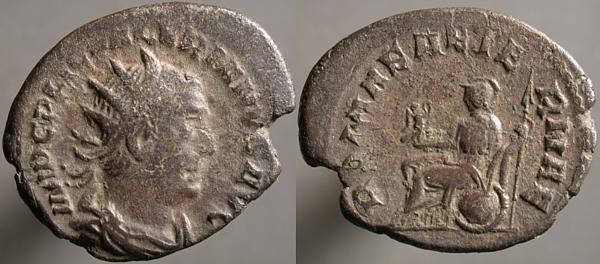
IMP C P LIC VALERIANVS AVG, Radiate draped cuirassed bust right | ROMAE AETERNAE, Roma seated left on shield, holding spear right and Victory left.
I've already posted a coin of this issue for Gallienus, but just obtained this, with his father Valerian on the obverse.
While this example isn't in the finest condition, it did come with a tag noting that it was auctioned by "Col. Art. Curri" in Dec 1929, as lot 1186, and was previously owned by Michele Bazzanowski of Milan. Nobody famous, as far as I know, but provenance, even if not terribly revealing, does add interest.
Friday, September 17, 2004
Æ26, Damascus in Coele-Syria, Gallienus, Sear GIC 4622
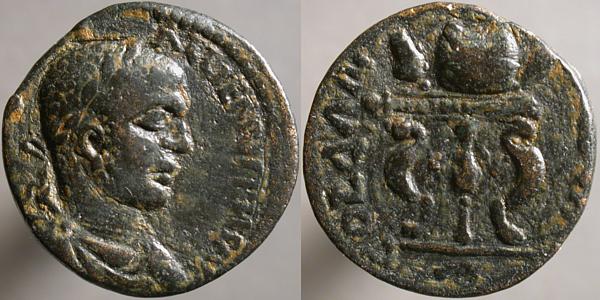
[IMP CAES P G]_ALLIENV[S PIO F AG], Laureate draped bust right | COL ΔAM_[AS METRO], Palm branch and prize crown with palm branches protruding on table.
Some of the cities that minted coins under ancient Rome have left so few other traces that their location isn't known with certainty. More are now uninhabited ruins, or insignificant villages. Many still exist but have changed their names in the centuries since. A few, like Damascus, capital of modern Syria, are still great cities with largely unchanged names.
This appears to depict the prize for a competition, perhaps athletic, a common theme on provincial coins of this reign.
Thursday, September 16, 2004
Found dog in Atlanta
If anyone in Atlanta's missing a border collie mix, see here.
No wonder everybody died of poison!
According to this afternoon's Snapple bottle cap, "In ancient Rome, lemons were used as an antidote to all poisons."
Æ antoninianus, Gallienus, Rome, Göbl 745b

GALLIENVS AVG, Radiate head right | DIANAE CONS AVG, Stag walking right, X in exergue.
These aren't particularly hard to find, but I specially like this one for the details in the stag's fur. A table at Jim's Virtual Coin Collection shows that, in the Cunetio hoard, over 40% of the "Zoo" coins were DIANAE CONS AVG types, featuring a member of the Cervidae.
Wednesday, September 15, 2004
AR denarius, Nerva, Rome, 96 CE, RIC 3
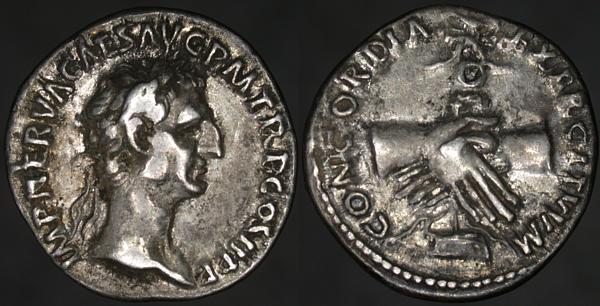
IMP NERVA CAES AVG P M TR P COS II P P, Laureate head right | CONCORDIA EXERCITVVM, Clasped hands in front of standard on prow.
If Domitian can be seen, at least in part, as a sort of Nero writ small, then Marcus Cocceius Nerva can be viewed as a parallel Galba. Like him, Nerva was an older, established, patrician, quite acceptable to the Senate, who believed they could control him.
Lacking military experience, Nerva managed to survive a mutiny by his praetorians, and adopted his eventual successor, Trajan, as part of a package of things done to mollify them. (A healthy cash donative helped, too. Lots.)
This package included a letter of thanks to the mutineers, and various further accommodations like this coin that's dedicated to the concord with the armies and takes no chances, depicting a military standard atop a prow, symbolizing the navy.
Nerva died in January, 98, weeks after suffering a stroke. The nose died with him, more or less.
Tuesday, September 14, 2004
Æ23, Iconium in Lycaonia, Gallienus, SNG Copenhagen 9
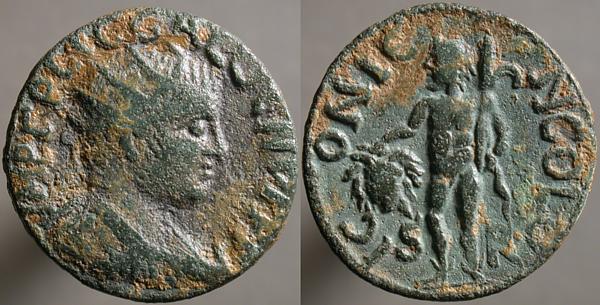
IMP Γ P LIC GALLIENVΓ P F A, Radiate draped cuirassed (clean-shaven!) bust right | ICONIE_N COLO, Perseus standing facing, head left, holding harpa right and head of Medusa left. S_R across fields.
Same obverse die as this post, but a more exciting reverse.
Iconium is today Konya, birthplace of the founder of the "Whirling Dervishes".
Monday, September 13, 2004
Silvered Æ antoninianus, Salonina, Antioch, Göbl 1619fT22
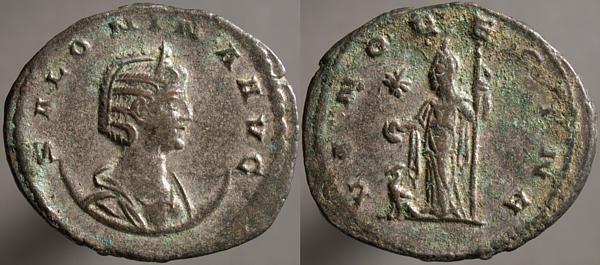
SALONINA AVG, Diademed draped bust right on crescent | VINO REGINA, Juno standing facing, head left, holding scepter right and patera left. Peacock at feet left. Star in left field.
It ought to say IVNO REGINA, but the legend is bungled in an amusing way. It's the second example I've found, both from the same mint and with the same placement of the star in the field. (Presumably this marks the officina or workshop.) They're from different dies though. The placement of the peacock and the angle of its head are quite noticeably different.
Göbl attests and plates a similar coin minted at Rome as T22, but doesn't mention it from Antioch.
Sunday, September 12, 2004
Æ27, Heliopolis in Coele-Syria, Valerian, SNG Copenhagen 440
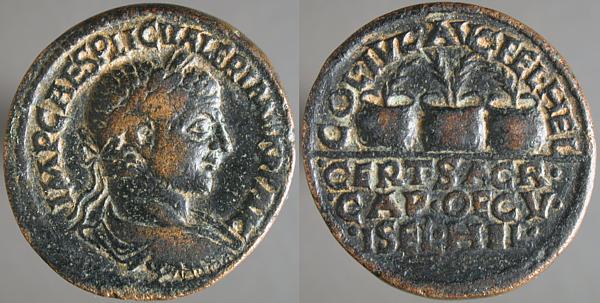
IMP CAES P LIC VALERIAN[VS] P F AVG, Laureate draped bust right | COL·IVL·AVG·FEL·HEL, Three prize crowns, two palms protruding from the center, one each from the other two. ·CERT·SACR· / ·CAP·OECV· / ·ISEL·HEL· in three lines in exergue.
Like Tuesday's coin, this is from Heliopolis (today Baalbek), and has a theme of athletic games. Where Tuesday portrayed a successful competitor, this advertises the honor and prizes to be won.
As cities with colony status usually did, Heliopolis uses latin legends on its coins here, and they are far easier for me to transcribe. Yay, Heliopolis!

